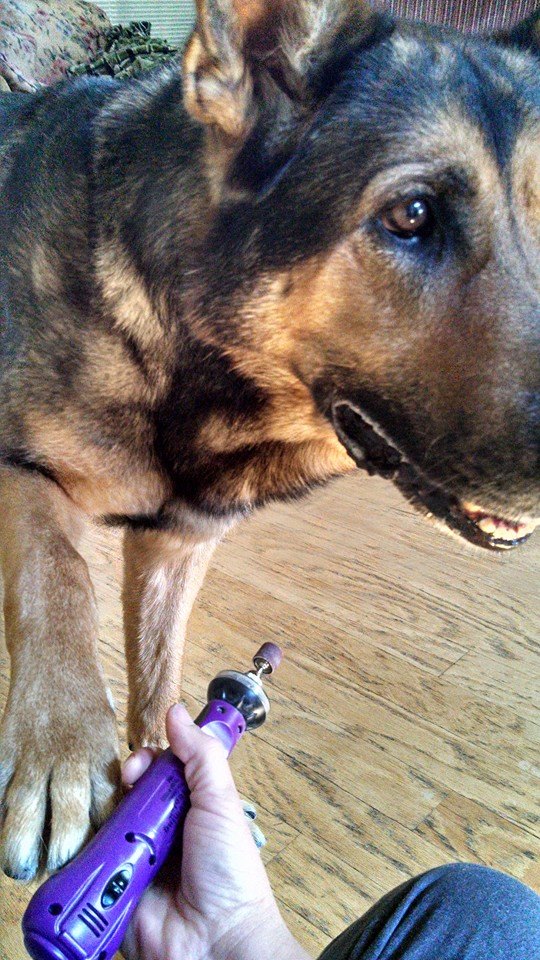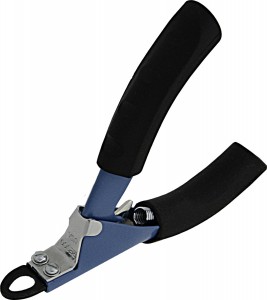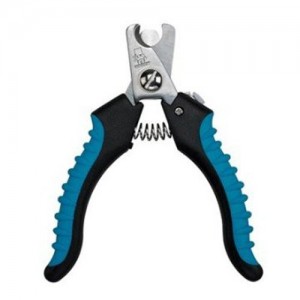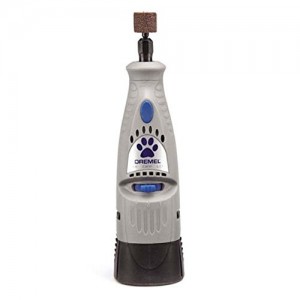Trimming Back the Nail
One of the primary reasons owners let their dogs’ nails get too long is because nail trimming becomes a battle. Their dogs loathe the clippers, and often do not cooperate. Because of this, many owners try to trim the dog’s nails as little as possible, while others wait and take their dog in to the groomer to let the professionals deal with their dog’s misbehavior during nail trims. Either way, the result is the same: the dog’s nails grow too long, and despite the trim, are still too long afterward. Unless owners are willing to trim their dog’s nails every week, or take them into the groomer every week to trim them back a little at a time, the nail will never be brought back to the short length that is beneficial for the dog.
Trimming the Nail
Last blog discussed the importance of a short nail. Our dogs must learn to accommodate a nail trim (and some dogs learn to LOVE their nail trim!), because nail trimming is an essential part of their care and their life with humans. If you have a puppy or a young dog, start this process now by getting the dog used to having his feet handled in a positive manner. This involves handling the individual toes for a period of time, not just picking up or holding the dog’s paw. This should be a highly rewarding experience, so break out your dog’s favorite treats!
If you have an older dog who hates having their feet handled, you will need to desensitize them to having their feet handled. This should be done without any association with trimming their nails at this point. Simply get them accustomed to having you touch their feet, pick up their paw, and eventually handle each toe. With a dog that really, really hates having their feet touched, this will take a while. Be patient, and practice this several times a day using the most scrumptious food you have to offer. You can even feed the dog their dinner through paw handling, where the dog is fed from your hand a little bit at a time, after he or she has allowed you to touch a paw.
 Once the dog readily accepts your handling of its feet, you can progress to the next stage of nail trimming: desensitizing the dog to the equipment of the nail trim. This involves taking out the nail clippers or nail grinder/dremel (we’ll get to this later) and rewarding the dog heavily for seeing it and not going anywhere, then for allowing you to bring it close to their paws, and eventually for touching the tool to the nail without actually clipping anything. When the dog tolerates this well, you can then move to the actual clipping.
Once the dog readily accepts your handling of its feet, you can progress to the next stage of nail trimming: desensitizing the dog to the equipment of the nail trim. This involves taking out the nail clippers or nail grinder/dremel (we’ll get to this later) and rewarding the dog heavily for seeing it and not going anywhere, then for allowing you to bring it close to their paws, and eventually for touching the tool to the nail without actually clipping anything. When the dog tolerates this well, you can then move to the actual clipping.
You may only accomplish one paw or even one nail during this first clipping. Start by going through the process of rewarding the dog for touching the tool to their nail. Then, you take a quick clip of the very tip of one nail, and then reward the dog with its favorite treats. If the dog is still calm and relaxed, go ahead and clip the next nail, and then reward. Stop after one paw, being sure to reward the dog after each small clip. Do this again the next day with another paw, and then another, and then the last, until all nails have been clipped. For now, you reward after each nail clip. When clipping, you are only taking off a very little bit; you are not trying to completely trim back the nail at this point. The goal is to reward and reinforce calm, proper nail trimming behavior in the dog, making this a more enjoyable experience overall for the animal. In another week, you can clip a little bit more off the nails, possibly rewarding after the second nail is complete rather than rewarding every nail. In this manner, you can slowly trim the nails back without quicking the dog and making the trim unpleasant.
Clippers versus Grinder
No discussion of nail trimming is complete without addressing the equipment used for the actual trim. Clippers have always been standard for nail trimming, allowing the owner to clip off the excess nail with one squeeze. Clippers work very well for smaller or medium-sized dogs, but for large breeds like our German Shepherd Dogs, who have thick, black, sturdy nails, clippers may not work as well. Not only is it difficult to gauge where the quick is, but the nail itself can be so strong that it is hard to cut through without squeezing excessively hard on the clippers.
 There are two types of clippers available: the pliers/scissors style, and the single blade guillotine style. The single blade style (seen here at the right) presses the dog’s nail against a hard immovable surface, and cuts it from one side with the guillotine blade. This style of clipper squeezes the nail with quite a bit of pressure, and may cause more discomfort to the dog because of this. Remember that underneath the hard shell of the nail is the soft dermis tissue, with its nerve endings and blood supply. The dog does feel this squeezing of the nail, and since it is only one blade slicing from the bottom, this pressure is concentrated where the nail is “pinned” against the non-cutting side.
There are two types of clippers available: the pliers/scissors style, and the single blade guillotine style. The single blade style (seen here at the right) presses the dog’s nail against a hard immovable surface, and cuts it from one side with the guillotine blade. This style of clipper squeezes the nail with quite a bit of pressure, and may cause more discomfort to the dog because of this. Remember that underneath the hard shell of the nail is the soft dermis tissue, with its nerve endings and blood supply. The dog does feel this squeezing of the nail, and since it is only one blade slicing from the bottom, this pressure is concentrated where the nail is “pinned” against the non-cutting side.
 A better choice for clippers is the pliers style (seen here at left), which cuts from both sides. This works better for the large thick nails, as it cuts the nail with two blades instead of pinning the nail against one surface and only cutting it in one direction. While the dog will still feel pressure from the trim, it should not be nearly as much as that experienced with the single-blade clipper. The scissors-style blade allows for twice the cutting power with the same amount of effort on your part.
A better choice for clippers is the pliers style (seen here at left), which cuts from both sides. This works better for the large thick nails, as it cuts the nail with two blades instead of pinning the nail against one surface and only cutting it in one direction. While the dog will still feel pressure from the trim, it should not be nearly as much as that experienced with the single-blade clipper. The scissors-style blade allows for twice the cutting power with the same amount of effort on your part.
 A nail grinder or a Dremel is another tool that can be used to trim back a dog’s nails (seen here at right). Many groomers, breeders, and dog handlers prefer the grinder to the clippers for several reasons. First, the grinder creates a smooth nail trim, with no edges to catch or scratch. Second, the nail can be shaped while also being trimmed back, allowing for a neater nail trim and neater paw overall. Third, the grinder allows the nail to be trimmed close to the quick without causing discomfort. Fourth, the grinder allows the you to see just how close you are getting to the quick and the dermis tissue, so you can stop before the dog gets “quicked”. When it comes to dogs with large, dark nails, this is invaluable!
A nail grinder or a Dremel is another tool that can be used to trim back a dog’s nails (seen here at right). Many groomers, breeders, and dog handlers prefer the grinder to the clippers for several reasons. First, the grinder creates a smooth nail trim, with no edges to catch or scratch. Second, the nail can be shaped while also being trimmed back, allowing for a neater nail trim and neater paw overall. Third, the grinder allows the nail to be trimmed close to the quick without causing discomfort. Fourth, the grinder allows the you to see just how close you are getting to the quick and the dermis tissue, so you can stop before the dog gets “quicked”. When it comes to dogs with large, dark nails, this is invaluable!
The use of a grinder does take some getting accustomed to, as there is an audible motorized noise with some vibration coming up the nail as the grinder does its work. For dogs that are sensitive to sounds or that are still quite skittish about their paws, the grinder may not be the best choice. But when used properly on a large dog, the grinder produces a very nice, neat nail “trim”. Because the spinning drum of the grinder does the work of the nail trim without applying pressure, it is often much easier to use to trim back those nails.
There are several online video tutorials that discuss how to grind a dog’s nails, but this one below provides a very quick overview with a good visual for using the grinder:
How To Dremel Your Dog’s Nails
Remember, if your dog currently hates its nail trim, this will be a long process of helping them learn to accommodate and even look forward to it, before you can even begin trimming back the nail. Take your time, and keep it highly rewarding!

